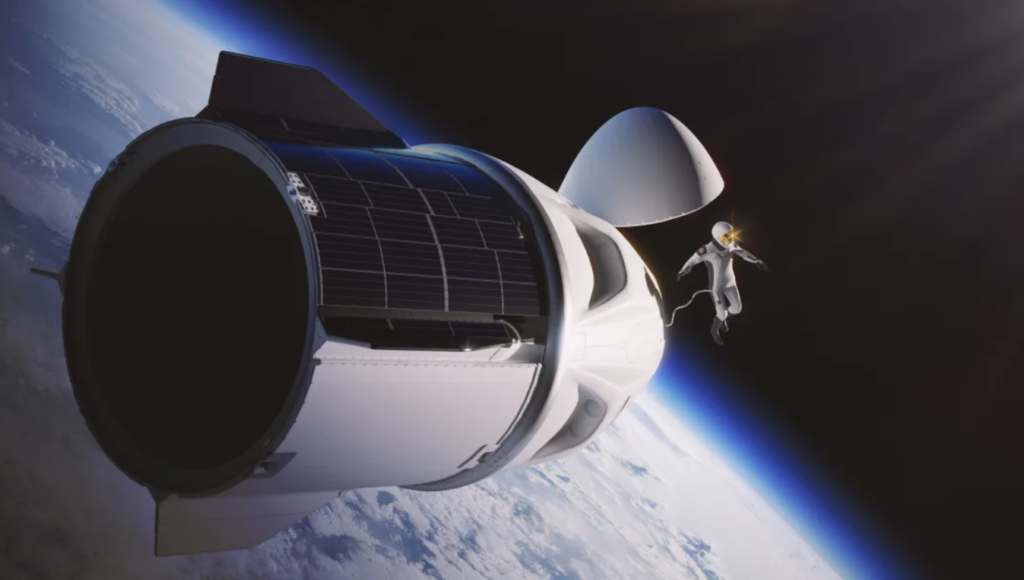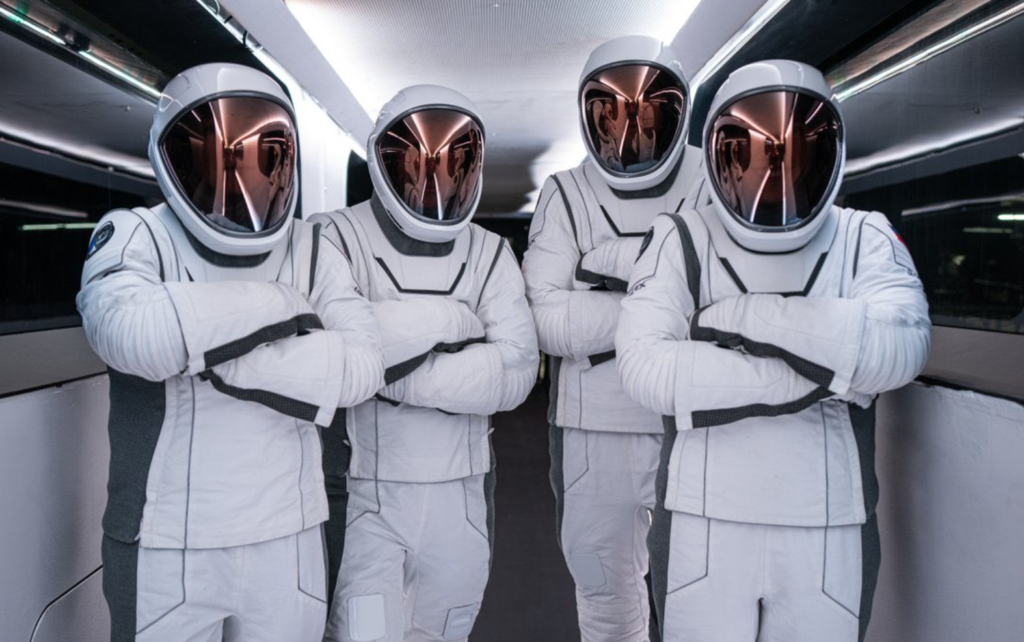With the final preparations underway, in less than 24 hours SpaceX will launch one of its most unique missions to date. Named Polaris Dawn, 4 humans will orbit the Earth on a Dragon spacecraft and complete the first commercial EVA or extravehicular activity among other milestones.
Right now SpaceX is preparing both the vehicle and crew after a successful static fire of the Falcon 9 along with a full launch rehearsal. Here I will go more in-depth into the mission’s initial flight profile, some of the milestones they aim to complete, what to expect over the next few days, and more.
Flight Profile

Yesterday on the 25th SpaceX confirmed in a tweet that they had successfully static fired the Falcon 9 and that the launch would occur on the 27th, at 3:38 am ET. This means we can expect a pitch-black sky as the rocket lifts off.
Only yesterday the mission readiness review was finished in prep for launch. Elon Musk tweeted saying, “The Polaris Program mission readiness review just finished and we are currently go for launch in just over 24 hours. Crew safety is absolutely paramount and this mission carries more risk than usual, as it will be the furthest humans have traveled from Earth since Apollo and the first commercial spacewalk! If any concerns arise, the launch will be postponed until those concerns are addressed.”
It’s clear based on this statement among others that SpaceX is taking this launch quite seriously thanks to its unique mission profile. In terms of what to expect, with the static fire already complete and successful, a launch on the set time is likely. Importantly, there are two additional launch opportunities within the four-hour window at 5:23 a.m. ET and 7:09 a.m. ET. Also, if needed, backup opportunities are available on Wednesday, August 28 at the same times.
Assuming it stays on schedule, you can expect a SpaceX livestream to begin 3 and a half hours before the actual launch. As for the rocket itself, at T-45:00, the SpaceX launch director will give the go for propellant load. At that point, the crew will already be on the vehicle practically ready for lift-off. The next 45 minutes will consist of the crew arm retracting, engine chill and startup, propellant loading, and finally liftoff. All of which are pretty much consistent with any other crewed launch.
However, soon after liftoff, we can expect some very different mission milestones. Despite the high Earth orbit requirements and distance, the booster will stay in a reusable configuration and land on a droneship out at sea. Looking at the mission profile provided by SpaceX, around 12 minutes in Dragon will separate from the second stage. Only around 40 seconds later they will begin the Dragon nosecone open sequence.
This is one of the first steps in Polaris Dawn’s spacewalk, which will mark both the first-ever commercial spacewalk and the first time that four astronauts will be concurrently exposed to the vacuum of space. In total, the spacewalk and general operation is expected to last around two hours. During the operation, Mission Commander Jared Isaacman and Mission Specialist Sarah Gillis will separately exit the Dragon spacecraft through its forward hatch. The other two astronauts will remain seated, managing spacesuit umbilicals and monitoring telemetry on Dragon’s interior displays. This will occur around 700 km above the Earth.
After a successful spacewalk, the crew will return inside the vehicle and work to complete some of the other mission milestones set out. For context, while the EVA is one of the main purposes of the launch, it will only take a fraction of the time considering the mission is set to last around 5 days in total. This leaves a good amount of time to complete other experiments and tests.
Arguably one of the first tests will be pushing the Falcon 9 and Dragon to its limits. SpaceX says in a statement, “This Dragon mission will take advantage of Falcon 9 and Dragon’s maximum performance, flying higher than any Dragon mission to date and endeavoring to reach the highest Earth orbit ever flown. Orbiting through portions of the Van Allen radiation belt, Polaris Dawn will conduct research with the aim of better understanding the effects of spaceflight and space radiation on human health” they said.
This will definitely provide some invaluable data to the company on both vehicles thanks to the distant orbit and requirements. If it launches on schedule, we can expect the crew to return by the end of the week likely around Saturday.
Spacesuit Upgrades

Over the last few months, SpaceX has been very busy testing its new spacesuit as the mission approaches. Like a few other aspects of the mission, this will be the first spacewalk using the SpaceX-designed extravehicular activity (EVA) spacesuits, upgraded from the current intravehicular (IVA) suit.
Evolved from the IVA suit, the EVA suit looks similar but provides greater mobility, a state-of-the-art helmet heads-up display (HUD) and camera, new thermal management textiles, and materials borrowed from Falcon’s interstage and Dragon’s trunk. SpaceX points out that all of these enhancements to the EVA suit are part of a scalable design, allowing teams to produce and scale to different body types as SpaceX seeks to create greater accessibility to space for all of humanity.
As far as relevant testing, last month the crew completed the final series of spacesuit testing. In a statement they said, “The Polaris Dawn crew recently completed a series of spacesuit acceptance tests in preparation for the mission’s extravehicular activity, or spacewalk, marking the final significant developmental and test milestone for SpaceX’s newly-developed EVA spacesuit.
These tests marked the first time the Polaris Dawn crew wore the spacesuit in a vacuum environment, which provided some necessary knowledge and familiarity. Some examples include an understanding of how the spacesuit performs in a vacuum, a collection of spacesuit and biometric data to assess the overall system’s performance in a flight-like environment, and even insight into the various thermal states expected throughout the spacewalk, among others.
This final spacesuit testing milestone actually took place at NASA’s Johnson Space Center in Houston, Texas, in late June, utilizing a historic chamber facility previously used to support testing of America’s earliest spacesuits and spacecraft during the Gemini and Apollo programs. Built in the mid-1960s, the facility was added to the National Register of Historic Places in 1985 and remains in use today to support various space industry tests.
With these steps complete, the crew should be much more experienced and comfortable in their new suits. Related to the design, SpaceX says, “Building a base on the Moon and a city on Mars will require millions of spacesuits. The development of this suit and the execution of the spacewalk will be important steps toward a scalable design for spacesuits on future long-duration missions as life becomes multi-planetary.
While we obviously are hearing a lot about the mission and recent training now, its been going on for years. The Polaris Dawn crew is in the final stages after more than two years of essential training activities preparing them for the landmark mission. This training has included centrifuge operations, hundreds of hours of Dragon simulations, skydiving, survival training, high performance aircraft piloting, Zero-G flight training and altitude training, as well as classroom academics and medical testing. Additionally, and especially important for Polaris Dawn, the crew received extensive EVA training, both underwater and suspended operations, as well as the associated medical training.
In a quote, Jared Issacman, the commander of the mission said, “After more than two years of training, we are excited to embark on this mission. We are incredibly thankful for this opportunity and to the thousands of SpaceX engineers who have contributed to this endeavor. Throughout our mission, we will aim to inspire humankind to look up and imagine what we can achieve here on Earth and in the worlds beyond our own” he said.
Besides the EVA and high altitude destination, over 30 other experiments are set to happen. In one instance, the Polaris Dawn crew will be the first crew to test Starlink laser-based communications in space, providing valuable data for future space communications systems necessary for missions to the Moon, Mars and beyond.
Other objectives include gathering data on the radiation environment to better understand how space radiation affects human biological systems. A lot of the focus is on human health related to long-term space travel.
A few days ago SpaceX posted images of the Dragon rolling out and going vertical on the pad. By now, this spacecraft has launched 46 times with 42 of those launches going to the International Space Station. This includes a handful of crew rotations with the Crew-9 launch set to happen next month. A mission that now will likely only launch two crew members rather than 4 in order to save room for Butch and Suni on the return.
The last time we saw a mission slightly similar to Polaris Dawn was Inspiration4. In that case, traveling weightless at over 17,000 miles per hour, the crew conducted experiments designed to expand our knowledge of the universe. Crew Dragon’s 365lbs cargo capacity was allocated for both crew essentials as well as scientific equipment dedicated to micro-gravity research and experimentation.
Inspiration4 assigned the maximum possible mass towards this valuable research, providing access to space for inspiring projects that are otherwise unable to overcome the high barriers of traditional space-based research. That successful mission helped pave the way for Polaris Dawn and even more unique missions in the future.
Conclusion
After years of preparation and training, SpaceX is less than 24 hours away from the scheduled launch of Polaris Dawn. Here we will see 4 astronauts launch on a Dragon in newly modified EVA spacesuits to attempt the first-ever commercial space walk.
